|
We have
already examined Buffalo Bore’s defense .357 Magnum
ammo. In the 125
grain end of the spectrum, anti-personnel low flash loads
are available. In the 180
grain, bear skull penetrating market segment, Tim Sundles
has again provided.
In the
middle, Buffalo Bore has two loads directed toward hunting. One
launches a 158 gr. JHP, of conventional weight and controlled
expansion characteristics. The other is the less usual 170 gr.
weight, same bullet construction.
As is
true of the 125s and 180s, owner Sundles has chosen new, non
canister grade propellants to provide high performance at
standard pressures. We have also noted accuracy with Buffalo
Bore .357s run the gamut of acceptable to quite good, and we saw
this in testing.
All in
all, 3 loads were tried with each gun. Range was 25 yards,
ambient temperature 85 Fahrenheit, winds nil. After we grouped
these guns, we recalled the single shot carbine stowed about
Church’s SUV, and it was fired for velocities.
The 3
single action revolvers used were a late model 5 ˝”
Ruger Bisley Vaquero, stainless and nearly new, a
4 5/8” Old Model Blackhawk, clean and unconverted, and the
gigantic, weird and accurate J P Sauer built Herter’s
Powermag, 6 ˝”. The former Camp Perry competitor Miles Fortis
pulled the trigger on all accuracy tests. He’s a way better
shot than Church.
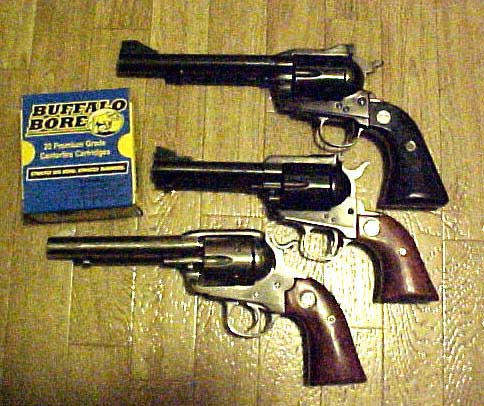
  
Buffalo Bore's 158-Grain Ammo
Old Model Ruger Blackhawk
The 1971
vintage Old Model Ruger provided one base pin jump with this
ammo. Retrofitted with an aftermarket steel grip frame and
ejector housing, it’s a handy packing size, with a few welcome
extra ounces.
Velocities
were: 1231, 1294, 1283, 1284 and 1335, AVG 1285, extreme spread
103.9 and a standard deviation of 37.1. The base pin jump was
the only malfunction experienced with any of the guns. The
primer sensitive Powermag we expected to tie up, this gun we
expected to run seamlessly. Life offers surprises.
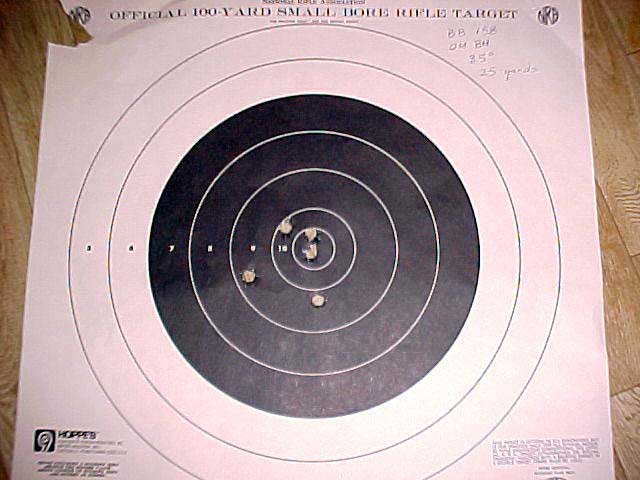
(Bullet hole
to the far left is a called flyer)
  
Herter's Powermag
The
German made 1966 proof date Herter’s Powermag is 49 ounces of
well made ugliness. Fitted with a mammoth grip frame,
ungainly hammer and sailboat sized sight protectors, it’s a
useful illustration of what the used market offers in off brand
beaters, and the dichotomy of cheap guns preferring high priced
ammo. Anyway, Church likes ‘em, they show up cheap, one was in
the vehicle, and so it got tested.
This gun
is also a barometer of soft primers. They will tie the gun up
quite decisively, primers flowing into the firing pin hole.
Nearly all Winchester factory loads do this in the test
Powermag. Another Sauer tested in the 180 article showed this
proclivity with both Winchester 125 and early lots of Buffalo
Bore 180 . None of this foolishness happened with either of
these mid-weight loads.
Velocities
were 1433, 1441, 1467, 1422 and another 1467. Average is an
expeditious 1446, extreme spread 45.7 and SD 20.6.

Decent,
but it liked 170 better.
  
"Del
Bisquero"
A
notably chunky and solid feeling gun of recent production, the
Bisley Vaquero has had some action smoothing, trigger weight
reduction (which we do at our own risk, and must advise you not
to even think about). No accuracy work as such as been
performed. This gun has served quite well already in CAS matches
shooting very low power .38 Special, but performed decently with
the .357 hunting ammo.
Velocities
were 1373, 1351, 1401, 1393 and 1355, average 1374, ES 49.9, and
SD 22.1

Fixed
sight gun, sights cut for Cowboy ammo. This is a happy
coincidence.
Finally,
author Church’s 16.5” barreled New England Firearms truck
gun was shot over the screens at the end of the day, with no
attempt made at grouping (we were out of targets, and the long
gun test was an afterthought). Bullets zooted forth at
velocities frighteningly close to those of the 170 load: 1676,
1750, 1751, 1678 and 1780, average 1727, ES 104.1, SD 47.3. You
will be later able to compare and barely contrast these against
the 170 numbers.
  
Buffalo
Bore's 170-Grain Ammo
The
slightly slower, heavier, and presumably more penetrative 170
grain load was shot in same guns as above. For some reason, the
perception straight across seemed to be that the 170 stuff was
softer recoiling. Certainly the base pin didn’t jump on the
shorty Old Model. Neither yet did it twist up the Powermag’s
firing pin bushing with incipient primer oozing.
It all
just went off, and grouped decently.
Old Model Ruger Blackhawk
The Old
Model packing gun provided speeds as follows: 1265 1248 1250
1305 1294 AVG 1273, ES 57.4, SD 23.6. Note that these numbers
are little different than the 158 numbers, a theme we will see
repeated.
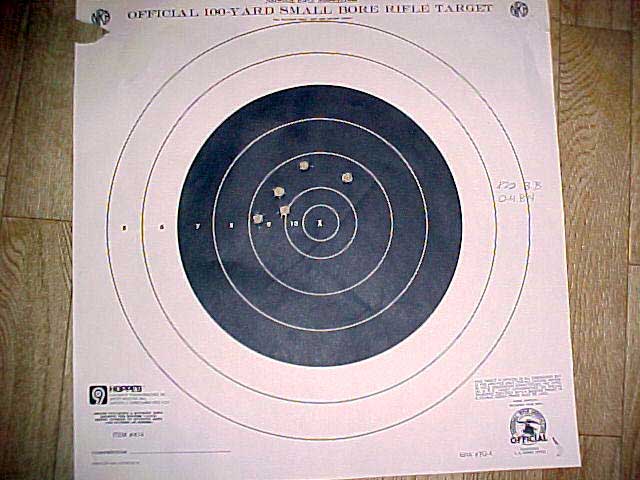
This
would work, but it liked the 158 better.
  
Herter's
Powermag
On to
the Powermag. The huge ugly German gun stepped the fastest of
all short arms with 1427 1401 1439 1458 1405 AVE 1426 ES 56.4 SD
23.6.
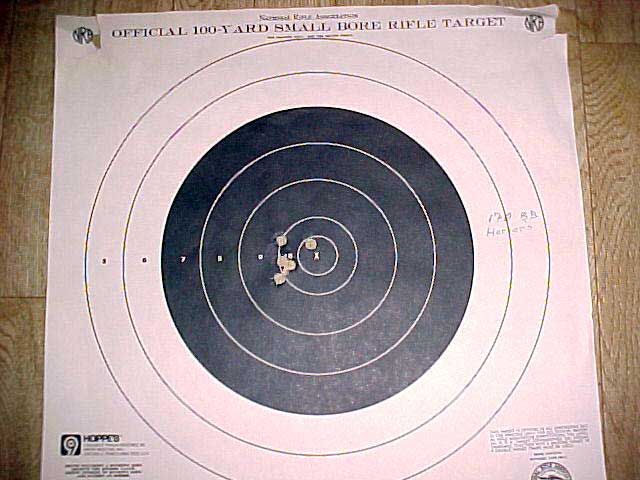
This is
pretty gilt-edged accuracy for a pawnshop truck gun, but judge
for yourself.
  
"Del
Bisquero"
The
Bisquero ran the middle course again with 1376 1353 1389 1345
and 1373. AVG 1367, ES 43.6, SD a tight 17.7
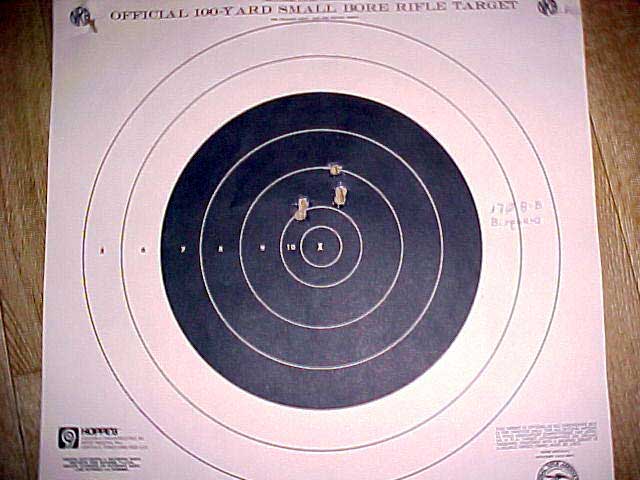
Note
that 4 of 5 holes are touching.
The NEF
carbine showed these numbers 1672 1719 1783 1759 1734 AVG 1733
ES 110.3 SD 41.8
Lacking
legal ability to shoot deer at the out-of-season time this
article was written, we have to trust the performance of Buffalo
Bore’s choice of bullets, but previous experience and feedback
leaves us confident. This is good performing, reliable ammo.
Miles
Fortis & A K Church
  
Got something to say about this article? Want to agree (or
disagree) with it? Click the following link to go to the GUNBlast Feedback Page.
All content © 2004 GunBlast.com.
All rights reserved. |
![]()